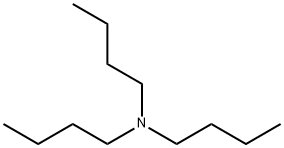| Detailed Description: |
Cas No. :102-82-9
Specs:99.5%
| | | Tributylamine Chemical Properties |
| mp | −70 °C(lit.)
| | bp | 216 °C(lit.)
| | density | 0.778 g/mL at 25 °C(lit.)
| | vapor density | 6.38 (vs air)
| | vapor pressure | 0.3 mm Hg ( 20 °C)
| | refractive index | n20/D 1.428(lit.)
| | Fp | 146 °F
| | storage temp. | Store at RT. | | Water Solubility | 0.386 g/L (25 ºC) | | Sensitive | Hygroscopic | | Merck | 14,9618 | | BRN | 1698872 | | Stability: | Stable. Combustible. Incompatible with strong oxidizing agents, strong acids. Hygroscopic. | | CAS DataBase Reference | 102-82-9(CAS DataBase Reference) | | NIST Chemistry Reference | Tributylamine(102-82-9) | | EPA Substance Registry System | 1-Butanamine, N,N-dibutyl-(102-82-9) |
| Tributylamine Usage And Synthesis |
| Chemical Properties | pale yellow liquid with an amine odour | | General Description | A pale yellow liquid with an ammonia-like odor. Less dense than water. Very irritating to skin, mucous membranes, and eyes. May be toxic by skin absorption. Low toxicity. Used as an inhibitor in hydraulic fluids. | | Air & Water Reactions | Hygroscopic. Slightly soluble in water. | | Reactivity Profile | Tributylamine can react with oxidizing materials . Neutralizes acids in exothermic reactions to form salts plus water. May be incompatible with isocyanates, halogenated organics, peroxides, phenols (acidic), epoxides, anhydrides, and acid halides. Flammable gaseous hydrogen may be generated in combination with strong reducing agents, such as hydrides. | | Health Hazard | TOXIC; inhalation, ingestion or skin contact with material may cause severe injury or death. Contact with molten substance may cause severe burns to skin and eyes. Avoid any skin contact. Effects of contact or inhalation may be delayed. Fire may produce irritating, corrosive and/or toxic gases. Runoff from fire control or dilution water may be corrosive and/or toxic and cause pollution. | | Fire Hazard | Combustible material: may burn but does not ignite readily. When heated, vapors may form explosive mixtures with air: indoors, outdoors and sewers explosion hazards. Contact with metals may evolve flammable hydrogen gas. Containers may explode when heated. Runoff may pollute waterways. Substance may be transported in a molten form. |
|

 T:Toxic;
T:Toxic; N:Dangerous for the environment;
N:Dangerous for the environment;


